Development of a Quality Management System (QMS)
Certifiable to ISO 9001:2015 Standard for the Department of Energy (DOE)
As of June 11, 2018
Lead: Policy Formulation and Research Division - Energy Policy and Planning Bureau
May 28 – 31, 2018 / Workshop on Quality Management System Documentation
The DAP Project Team conducted a workshop and facilitated the formulation of structure and controls for Quality Management System (QMS)-required information necessary for the effective implementation of the DOE’s QMS. This workshop aims to document the information required by the QMS, as well as, the existing management approaches of the DOE.
The expected outputs are:
- Draft QMS Manual;
- QMS Tools, Forms and Procedures such as Control of Documented Information, Internal Audit, Control of Non-Conforming Products and Services, Customer Satisfaction Determination and Corrective Action;
- Knowledge management tools and forms.
| Date / Particulars |
Activity / ies |
Remarks |
| 28 May 2018 |
- Reviewed the requirements on documented information as a provisions for the Performance - Based Bonus aligned on GQMC MC 2016-01
- Plenary discussion of the proposed document structure and the document template. DAP provided standard format for the Manuals.
- Assignment of topics for the drafting of the Manual, i.e Volume 1 for EPPB and Volume 2 for all Bureaus (including EPPB for the particular scope) and Services to be consolidated into one Quality Manual and Procedures Manual for the Department of Energy certifiable to ISO 9001:2015.
|
With Workshops / Photos -
|
| 29 May 2018 |
- Plenary review on the content of Quality Manual;
- Introduction - defines and clarifies policies, systems, and procedures adopted to implement and continually improve the Quality Management System (QMS) of the DOE;
- Agency Profile – defines DOE history, mandate, mission, vision, and core values;
- Organizational Structure – Organizational Chart and functional description of each bureau / services / unit / offices;
- Scope and Coverage - The scope covers the management, operations, and support processes of the Department as indicated in the DOE’s Process Map / Citizen Charter;
- Quality Policy - The Management shall maintains the Quality Policy, to ensures the satisfaction of the DOE’s clients and other interested parties, and compliance with statutory and regulatory requirements relative to the energy services. This policy is communicated to make sure that it is understood and applied at all levels of the organization. Comprehension of the Quality Policy is verified through, but not limited to, Internal Quality Audits (IQA), Management Reviews and during staff meetings.
The MANAGEMENT ( kindly take note ) is responsible for ensuring that the quality policy is appropriate to its mandate and provides framework for establishing and reviewing quality objectives and goals. This is reviewed periodically to ensure continuing suitability to its mandate and thrusts, including the requirements and needs of its clients.
During the previous workshop and as stated in the preceding progress reports, the QMS Core group/participants come up with the Quality Policy for approval of the Management, as follows:
“We, at the Department of Energy are committed to perform our mandate in compliance with governing laws, rules and regulations designed to meet the requirements of Quality Management System to further promote Good Governance and to continually improve the effectiveness of providing quality energy services.”
- Management Process – description of management process and indicating responsible units for each activity or procedure;
- Core Operations – Core processes of each unit;
- Support Process – support processes from other divisions such as HRMD, General Services, Procurement Services, Financial Services, Records Management and other units as needed in the process;
- List of Interested Parties’ Requirements… - General description of the DOE’s clients and interested parties;
- Risk Registry and Action Plan - General description of how the DOE identified the issues and risks;
- Control of External Providers - General description of how the DOE control its suppliers. To include / mention here the RA 9184 (Procurement Act) processes, the inspection and acceptance of goods, evaluation, purchases of goods and services, consultants and infrastructures, outsourced processes, rentals of equipment and other processes relative to procurement.
The participation and coordination of the Administrative Services - Procurement Management Division is significant in this section.
- Reference Matrix – This is the REFERENCES (i.e. RAs, EOs, Office Orders, manuals, procedures, flow charts, etc.) for the processes. Also, specific title and document number of references (e.g. RA No. 9184 – Procurement Act, Special Order, Implementing Guidelines for Data Collection, Procedure on Selection and Hiring, Citizen’s Charter, etc.)
- Improvement Plan – defines the objectives why the need to improve, must mention the key performance indicator, baseline data, target, action plan, responsible unit, completion time and monitoring method.
|
With Workshops (Photos)
|
| 30 May 2018 |
- Plenary review on the content of QMS Procedures Manual requirements:
- Control of Documents - this procedure is to ensure that all documents needed for the quality management system are kept up-to-date and are readily available for use by those who need them;
This procedure applies to all internal and external documents identified by DOE as required by the quality management system like document tracking sheet, acknowledgment receipt, and document masterlists.
- Control of Records - this procedure is to ensure that all records generated by the quality management system are properly maintained and are readily available for use by those who need them.
This procedure applies to records required by ISO 9001 as well as records identified by the organization as required for the effective management and control of processes.
The participation and support of the AS-Records Management Division is vital in this section, particularly on the part of the records retention and disposition schedule, as provided and in compliance with the rules and regulations of the National Archives of the Philippines (NAP).
- Internal Quality Audit - This document describes the procedure and resource requirements for the objective evaluation of the effectiveness of the established quality management system of the DOE.
This is where the planning, preparation, execution, follow-up, and reporting of IQA activities is determined, and if the Quality Management System (QMS) conforms to the planned arrangements, to the requirements of ISO 9001, and to the established QMS, so that provisions for the QMS is effectively implemented and maintained.
- Control of Nonconforming outputs and corrective action - The purpose of this procedure is to ensure that products and services that do not conform to the requirements are controlled to prevent their unintended use or delivery, or if delivered, to ensure that appropriate remedies are effectively taken.
- Control of Nonconformity Matrix – This is the procedure for process in operation, support and management with initial disposition and correction.
- Corrective Action Form – Details of Nonconformity, necessary actions and corrective action status report.
- Corrective Actions - The purpose of this procedure is to ensure that causes of detected nonconformities are eliminated in order to prevent recurrence.
Plenary discussion on inputs (QMS Outline) for the drafting of Procedures
|
Workshops /Exercises
|
| 31 May 2018 |
- Plenary presentation and enhancement of the draft procedures / tools:
- Documented information - Information required to be controlled and maintained by DOE and the medium on which it is contained such as QMS Manual, SOPs (Procedures and Work Instructions Manual / Operations Manual), Guidelines, Plans and Contracts.
- Internal Audit - The DOE shall conduct internal audit at planned intervals to provide information on whether the quality management system:
a. conforms to:
a.1 The organization’s own requirements for its QMS;
a.2 The requirements of the International Standard;
b. is effectively implemented and maintained.
The participation of the DOE’s Internal Audit Division plays a vital role in this section.
- Control of NC outputs and corrective action - Ensure that outputs that do not conform to requirements are identified and controlled to prevent unintended use or delivery.
- Customer Satisfaction Determination - This requirement can be demonstrated through the following:
Structured Approach:
- Training/program evaluation
- Project /program evaluation
- Client satisfaction/dissatisfaction survey
- Project deliverable acceptance
Customer Satisfaction Unstructured Approach:
- Regular meetings (briefings/debriefings/ assessment) with clients
- Website feedback tab/window
- Suggestion box
- Focus Group Discussions (FGD)
- Management Review - Top management shall review the DOE’s QMS, at planned intervals, to ensure its continuing suitability, adequacy, effectiveness, and alignment with the strategic directions of the organization
- Workshop integration and action planning on the final review, approval and packaging of the documents
|
With Workshops (Photos)
|
June 6 - 8, 2018 / Seminar-Workshop on Streamlining Frontline Services
The DAP Project Team presented streamlining frontline services process or the value stream map to enhance the process owner’s understanding of the streamlining principles, and the capability in utilizing relevant tools and techniques. Workshop on actual process review, work simplification, reduction of unnecessary steps and waste elimination was facilitated to increase the DOE’s effectiveness and efficiency in the delivery of its services.
The expected outputs are the enhancement of the operational procedures, and opportunities for improvement in the DOE’s operations.
| Date / Particulars |
Activity / ies |
Remarks |
| 06 June 2018 |
- Discussed Lean Management Process / Tools
- Lean Management tools is about waste elimination in the processes.
- It is also about expanding capacity by reducing costs and shortening cycle times between required services and target date.
- Understanding what is important to the customer.
- Lean management process is NOT about eliminating people.
- Discussed the five (5) lean principles:
- Specify what does and does not create value from the customers perspective;
- Identify all steps necessary to design, order and produce the product across the whole value stream to highlight non value adding waste.
- Make those actions that create value flow without interruption, detours, backflows, waiting or scrap.
- Only make what is pulled by the customer.
- Strive for perfection by continually remove waste
- Lean management is a systematic approach to identifying and eliminating non-value added activities through continuous improvement by flowing the product at the pull of the customer in pursuit of perfection.
- Lean or streamlined is the science of responsiveness to the customer
- The 7 + 1 types of waste (muda) was also discussed:
- Defect
- Over production
- Waiting
- Non-utilized people
- Transportation
- Inventory
- Motion
- Extra processing
- Lean Tools was also discussed like 5S, Just in Time (JIT), 7 waste, audits, standardized work, bottleneck analysis, kaizen, value stream mapping, among others.
- As a reality check, the adoption of Lean Management is not that easy.
- Lean culture can’t and won’t happen overnight;
- Time, efforts and commitments are required;
- Results on bottom line is expected from the lean initiatives;
- There is always the comfort zone of the status quo to fall back on; and
- Problems will be exposed and visible;
- It can be more stressful to response to problems quickly when they are more visible;
- People may feel threaten when their performance are visible to all and compared across the board;
- There will always be people who profit from the old system and will give reasons against the change;
- Perception of relinquishing the power of decision-making from the middle-management;
- It is always easy to ask “who” than “why” because the former makes the problem of ohers;
-
- Like what Charles Darwin says “ it is NOT the strongest of the species that Survive, NOR the most Intelligent, BUT the one most Responsive to Change”
- Workshop per bureau / unit on value stream map.
|
With Workshops / Photos
|
| 07 June 2018 |
- Success factor in Lean Management Process
- Prepare and motivate the people;
Create widespread orientation for continual improvement
Create common understanding of the need to be lean.
Push decision-making to the “lowest level”
Train and empowered people.
- Share information and manage expectation;
- Identify and Empower Champions;
Remove roadblocks (people and process).
- Leadership and Commitment;
- Lean Techniques: 5S (seiri, seiton, seiso, seiketsu and shitsuke)
- Continuation on the improvement of value stream workshop per bureau / unit.
|
With Workshops / Photos
|
| 08 June 2018 |
- Discussed Value Stream Management:
- A process for measuring, understanding,
and improving the flow and interactions of
all the associated tasks to keep the cost,
service, and quality of a company’s products/
services as competitive as possible.
- Identified continued opportunities to enhance value, eliminate waste, and improve flow.
- Applied the Plan, Do, Check and Act (PDCA).
- Workshop exercises on the scope of processes for each bureau / services / units identifying the current state, future state, workplan and implementation, which is the goal of mapping.
- There should be a Value Stream Team lead by Value Stream Head / Manager to lead the future state design implementation across functional and departmental boundaries.
- Six (6) steps to creating a site-level current state map:
- Document customer information and need.
- Identify main processes (in order)
- Select process metrics
- Perform value stream walk-through and fill in data boxes, including inventory and resident technology
- Establish how each process prioritises work Inventory
- Calculate system summary metrics, such as lead time versus process time, first-pass yield, cost, and/or other value stream summary measures.
- Waiting for Anything (People, Materials, Machines, or Information) is WASTE
- Processing things that the customer doesn’t want or even recognize (and is unwilling to pay for ) is the waste of processing
- Redoing, Correcting, Reworking – All are waste
Cause and Effect or Ishikawa Diagram
Practice the following:
- Find, Theme, Vote and Identify key PROBLEMS
- Find, Theme, Vote and Identify the CAUSE of the 1st Problem
- Find, Theme, Vote and Identify the Cause of the Cause of the 1st PROBLEM
- Repeat Step 2
- Repeat Step 3
- Lean implementation Planning:
- Break the work plan into loops
Post – Approval Loop
Order – Entry Loop
- Prioritize Loop Implementation
- prioritise kaizens within loops and minimise implementation resources, use common sense approach
- Continuation of Workshop per bureau / unit on value stream map (improve state).
OTHER ISSUES / CONCERN / UPDATE:
Update on the attendees for ISO 9001:2015 QMS:
- EPPB
- ERDB
- OIMB
- REMB
- EPIMB
- EUMB – no representative ( need to call their attention thru Memo. Preparation of QMS Quality and Procedures Manual have already been started and this might affect the preparation of QMS Volume 1 and 2.
- Services representative from HRMD, PMD, Treasury, Records Management Division, CWPO, General Services and Supply Division, also participated and presented their process output.
- ITMS representative attended only on June 6, 2018. There are concerns raised during the value stream mapping that need to be addressed by their group.
- ERTLS – LATL presented a good Value Stream Mapping output. Though the group were already ISO 17025, DAP Consultant advised to use / adopt the Standard Template for QMS 9001:2015 using / indicating some links with ISO 17025.
- Representatives from Field offices - Luzon, Visayas and Mindanao attended the QMS Training / Workshop since the start of the program in May 2018 to date.
- Ms. Lilian C. Fernandez, CREC Secretariat presented during the value stream mapping of REMB, the FLOWCHART UNDER DEPARTMENT ORDER NO. DO2017-04-0005 OR GUIDELINES IN THE PROCESSING OF APPLICATIONS FOR RENEWABLE ENERGY SERVICE/OPERATING CONTRACTS to clarifies some confusions on the handling / processing of RE applications.
- Ms. Nelly Zabala of the Records Management Division, reiterated with the bureau / services / unit concern on the guidelines in handling records receipt of applications / documents and other concern with respect to Freedom of Information Bill rules and regulations and NAP.
- ERDB requested to change / amend the scope of their process as stated in the Department Order from PCECP to Application for Sub-Contract Registration (covers both coal and petroleum process)
- Reminded all the QMS Team participants to start working on their respective Quality Manual / Procedure Manual using the DAP-QMS Template / Forms and Matrix.
|
With Workshops / Photos
|
Exercises on Value Stream Mapping - Current State
Consumer Welfare and Promotion Office
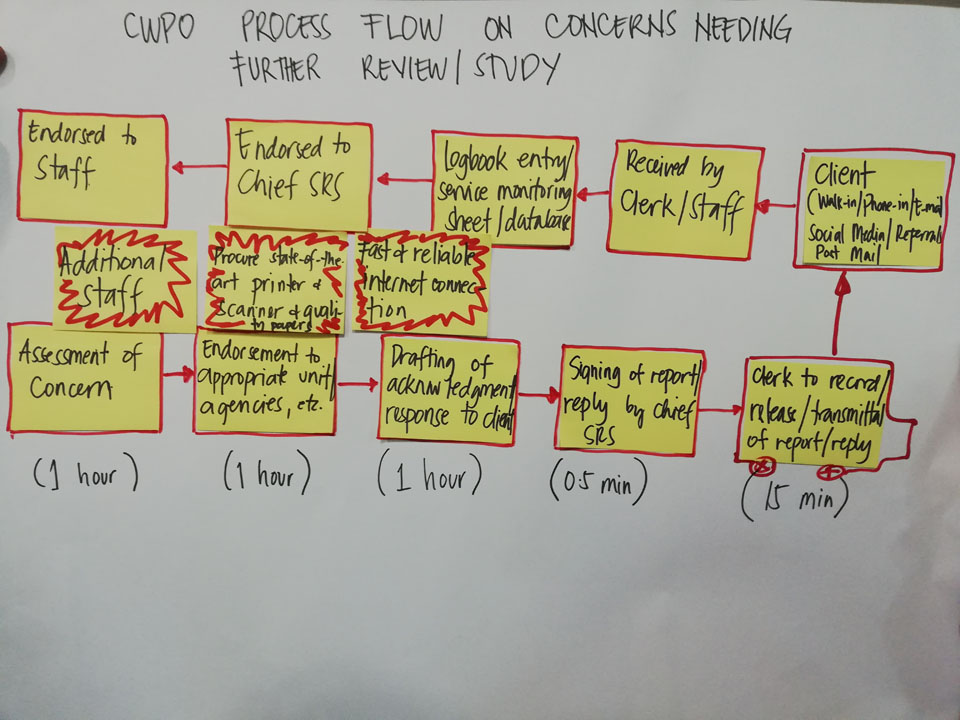
Electric Power Industry Management Bureau
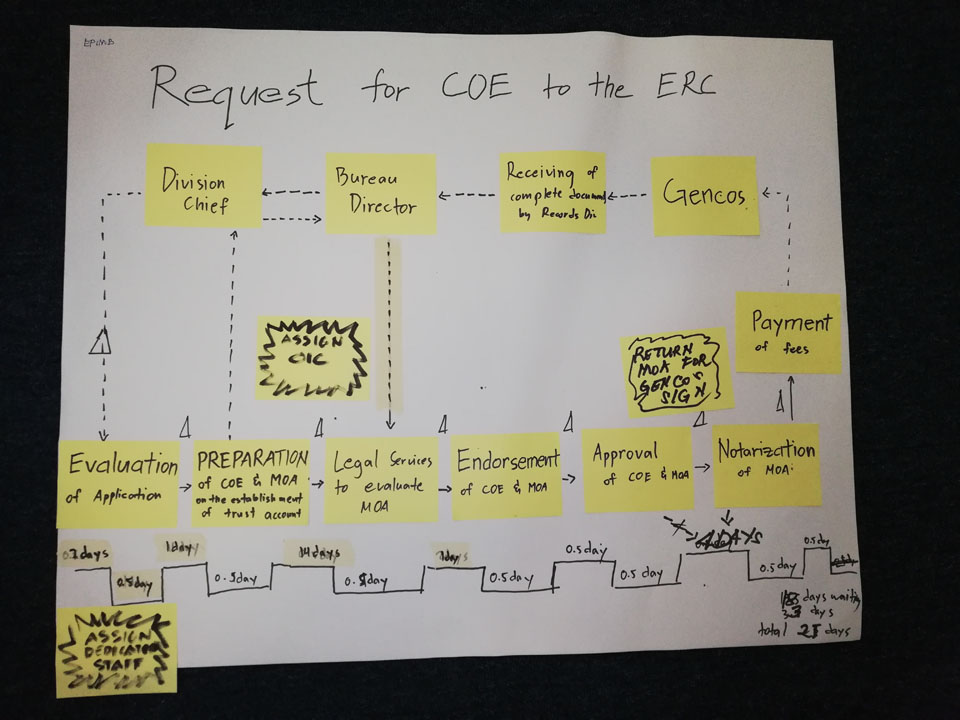
Energy Policy and Planning Bureau
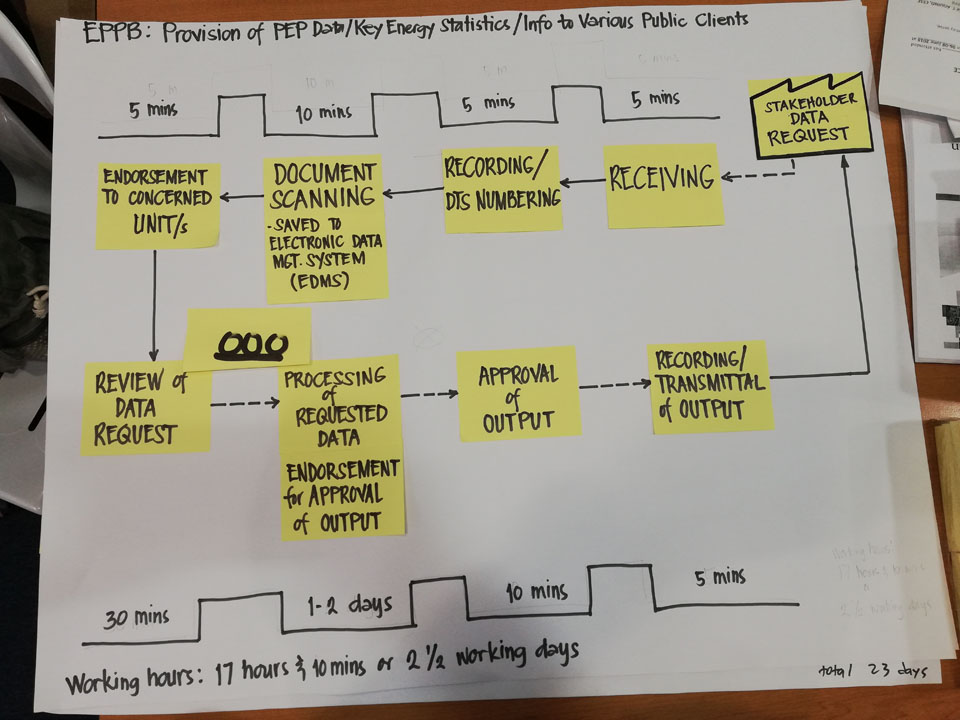

Energy Resource Development Bureau

Energy Research Testing and Laboratory Services
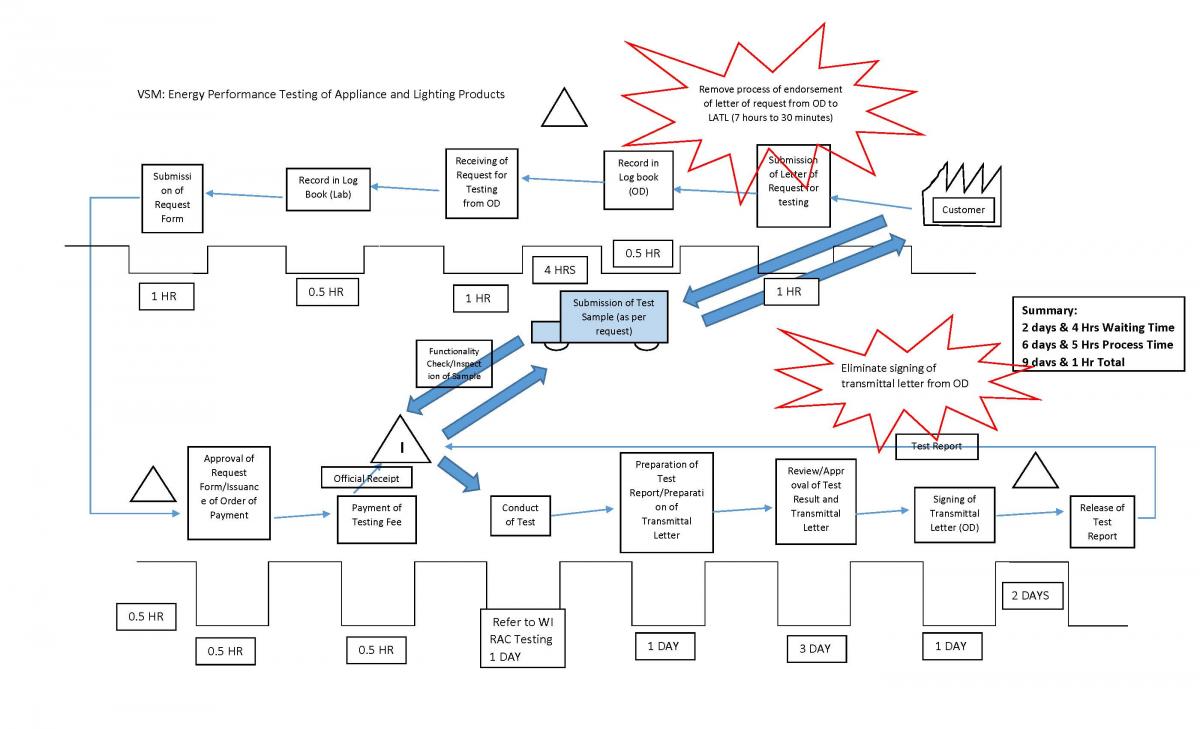
Field Offices

Human Resource Management Division

Oil Industry Management Bureau

Procurement Management Division


Records Management Section
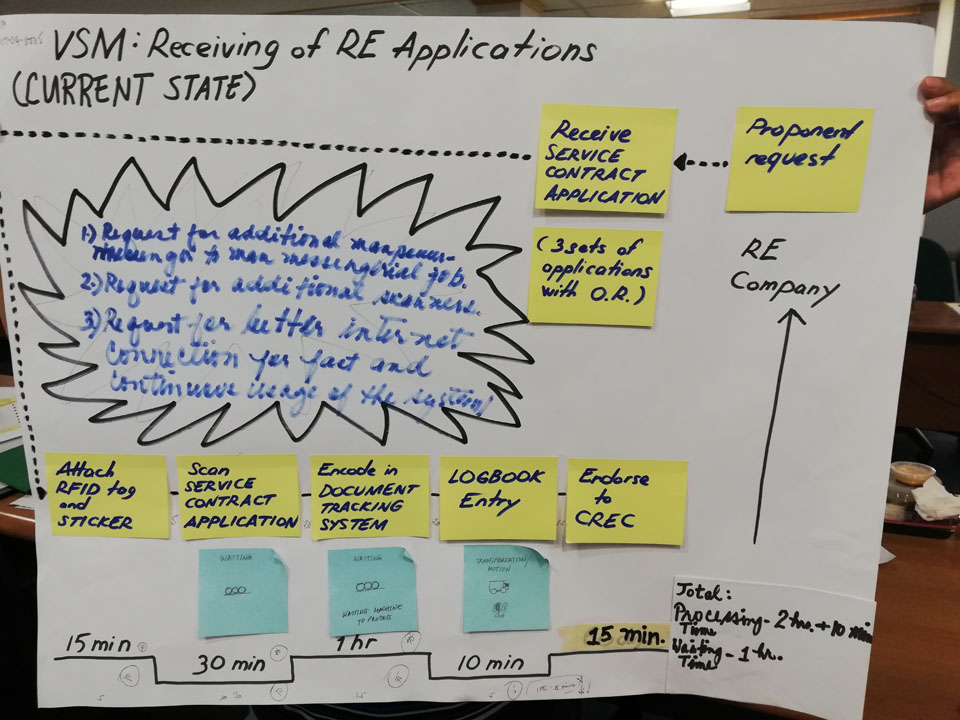
Renewable Energy Management Bureau
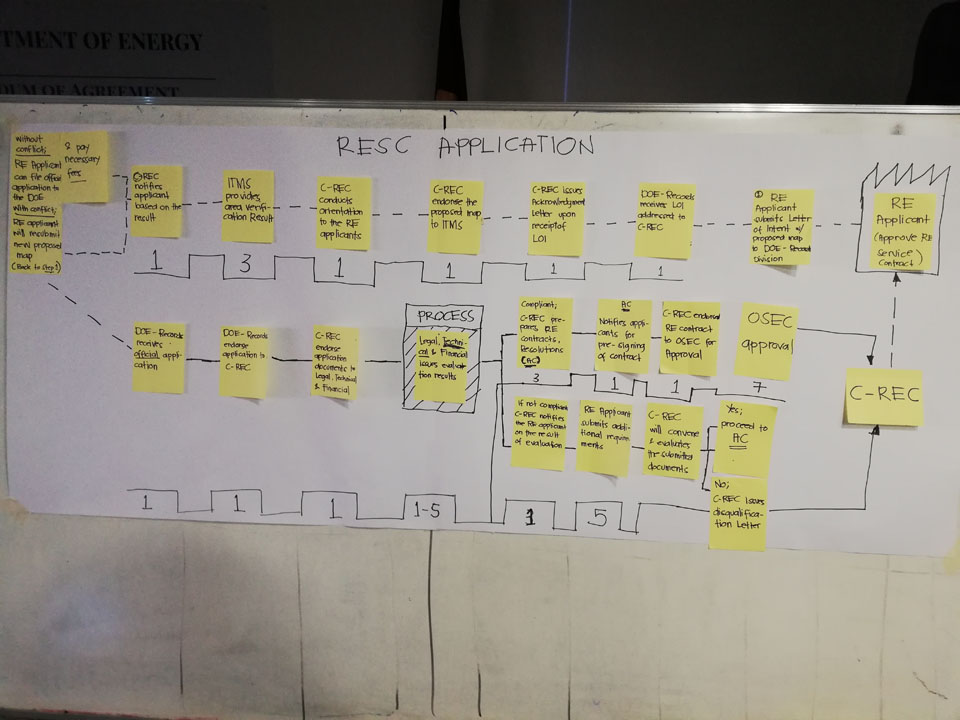

Exercises on Value Stream Mapping - Future State
Consumer Welfare and Promotion Office

Electric Power Industry Management Bureau

Energy Policy and Planning Bureau


Energy Resource Development Bureau

Energy Research Testing and Laboratory Services

Field Offices

Human Resource Management Division

Procurement Management Division



Records Management Section

Renewable Energy Management Bureau




























